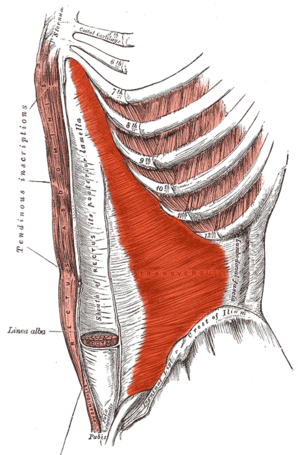Have you been wondering why you just can’t get that Mommy belly to flatten out? Have you ever heard of a diastasis? Diastasis technically means “the separation of parts of the body that are normally joined together, such as the separation of certain abdominal muscles during pregnancy, or of adjacent bones without fracture.” (Thank you Wikipedia).
 Image via WikipediaThe type of diastasis I deal with regularly in my practice is the first example given above—the separation of muscles in the abs that occurs during pregnancy. When a woman is pregnant, and her pregnancy continues to grow, the rectus abdominis muscles often split apart (think of that “6 pack ab” area of your body) in order to make way for your increasing belly. You can feel this condition if you know where to look, or “feel,” as the case may be. If you lay on your back and put your fingers a few inches from your belly button and lift your head, you can sometimes feel a ridge sticking out of the middle of the abs. This is the diastasis I am talking about.
Image via WikipediaThe type of diastasis I deal with regularly in my practice is the first example given above—the separation of muscles in the abs that occurs during pregnancy. When a woman is pregnant, and her pregnancy continues to grow, the rectus abdominis muscles often split apart (think of that “6 pack ab” area of your body) in order to make way for your increasing belly. You can feel this condition if you know where to look, or “feel,” as the case may be. If you lay on your back and put your fingers a few inches from your belly button and lift your head, you can sometimes feel a ridge sticking out of the middle of the abs. This is the diastasis I am talking about.A lot of women I have trained have developed this condition during pregnancy, and sometimes it can heal on its own, but there are many exercises that can be done in order help it heal (or to prevent it getting worse). Further, one of the keys is that you have to know how to do the right exercises to do in order to not make it worse. I think this is one of the reasons some women feel they can never get rid of that “pregnancy paunch”—because they are not doing the right exercises to get rid of it, and they are doing in fact the exact wrong exercises to exacerbate it. For instance, in order to heal a diastasis, you shouldn’t be doing crunches, which is probably the first thing a lot of people think of when they are worried about a protruding belly. Exercises that focus on the internal obliques and the transversus abdominis are great options both before and after pregnancy to help with a diastasis problem. You also need a trainer who knows how to look for this problem, and most importantly, knows how to avoid certain exercises that intuitively, might seem like a good idea, but will only make the condition worse.
Pilates can be a great option to help with a diastasis problem because exercises can be tailored to the individual and to that individual’s body—there is no one size fits all in Pilates in general, or at Indianapolis Pilates by 15 to Fit. Check out our website if you are in Indianapolis for great info on classes (http://www.15tofit.com/) or check out my great workout videos for expecting Moms and post partum Moms (www.gomomfitness.com). There is hope!



